By Ryan Gowland
New World’s fascination with the “women in prison” film can be blamed on two things: the Philippines and Larry Woolner.
When Roger Corman started New World Pictures in 1970, he wasn’t immediately sure what kind of films he was going to make. He was already locked into a two-film deal with United Artists – of which his penultimate directorial effort VON RICHTOFEN AND BROWN was a part – and was hoping to use the profits from the deal as collateral for his new company. Corman was offered an adaptation of John Updike’s novel Couples, but beofre he agreed he turned to Larry Woolner, who was joining New World as its first President of Sales and Distribution. Woolner and his brothers had owned a chain of drive-in theaters in Louisiana and had distributed a couple of Corman’s films, including 1956 SWAMP WOMEN, so Corman felt Woolner had a good instinct on what audiences wanted to see. Woolner’s initial idea was for a “student nurse” film, what would eventually become Stephanie Rothman’s THE STUDENT NURSES (1970). According to New World story editor Frances Doel, Woolner had another idea as well: “‘a women-in-prison film.’”
“Roger asked Larry what he meant by a ‘women-in-prison’ picture,” Doel explained to Stephen Armstrong in Roger Corman’s New World Pictures, 1970-1983: An Oral History, Vol. 2. “Larry started making this very expressive gesture, as if he were holding up female breasts. He said ‘You know. These. These!’ That was the beginning of the ingredient of some nudity, not full frontal, but breast nudity, that Roger always asked for.”
Add to the mix the biker film genre Corman already had success with during his American International Pictures days, and New World Pictures was off and running.
The Philippines setting, where Corman set up production for his early women-in-prison films, was suggested by actor-turned-producer John Ashley who was working with exploitation director John Romero on a series of “Blood Island” films in the location, and had just finished BEAST OF THE YELLOW NIGHT (which Corman would pick up for distribution). As revealed in Mind Warp! The Fantastic True Story of Roger Corman’s New World Pictures by Christopher Koetting, Ashley explains that Corman was looking to make a film in Puerto Rico, but Ashley suggested the Philippines instead (what film Corman was inquiring about is unclear, but Corman had had success shooting a trilogy of films in Puerto Rico, of which BATTLE OF BLOOD ISLAND was a part). In turn, Corman contacted Cirio Santiago, a Filipino filmmaker he had met while on a scouting trip for AIP, who would then serve as production supervisor on Corman’s first Filipino production, 1971’s THE BIG DOLL HOUSE (listen to our episode about it here).
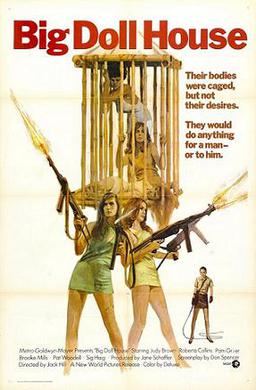
“They told me about this idea – basically they wanted to do a spinoff on a film called 99 WOMEN which they believed showed there was an audience for this sort of thing,” director Jack Hill explained to Calum Waddell in Jack Hill: The Exploitation and Blaxploitation Master, Film By Film. “But they believed that they could do something better.”
Hill had already worked for Corman writing and directing sections of THE TERROR and had just finished a disastrous experience working on ICH, EIN GROUPIE (aka HIGHER AND HIGHER) for producer Erwin Dietrich. Corman was set to release the film in the U.S. until the film ended up with an X rating (Hill took his revenge by using the producer’s last name for the evil prison warden in BIG DOLL HOUSE). The results working for Corman this time around were more successful for Hill, and THE BIG DOLL HOUSE became one of New World’s biggest hits, despite Corman not being immediately convinced.
“At first, I didn’t like THE BIG DOLL HOUSE,” Corman told Chris Nashawaty in Crab Monsters, Teenage Cavemen, and Candy Stripe Nurses. “I thought it had gone a little too far with the sex and violence. It cost about $100,000, and it grossed something like $4 million.* When I saw the grosses, I have to admit, my scruples faded away and I said, ‘Let’s make another one.’”
That “another one” Corman was referring to was likely THE BIG BIRD CAGE, as Corman had already made “another one” before THE BIG DOLL HOUSE was released: 1971’s WOMEN IN CAGES (listen to our episode about it here), which used much of the same cast as THE BIG DOLL HOUSE. In her autobiography Foxy: My Life in Three Acts, Pam Grier explained that the impetus to make another film occurred watching dailies for THE BIG DOLL HOSUE. “…with the success of the dailies,” wrote Grier, “they were writing another movie, and I was amazed when Roger asked me, ‘Would you like to stay and do one more?’”
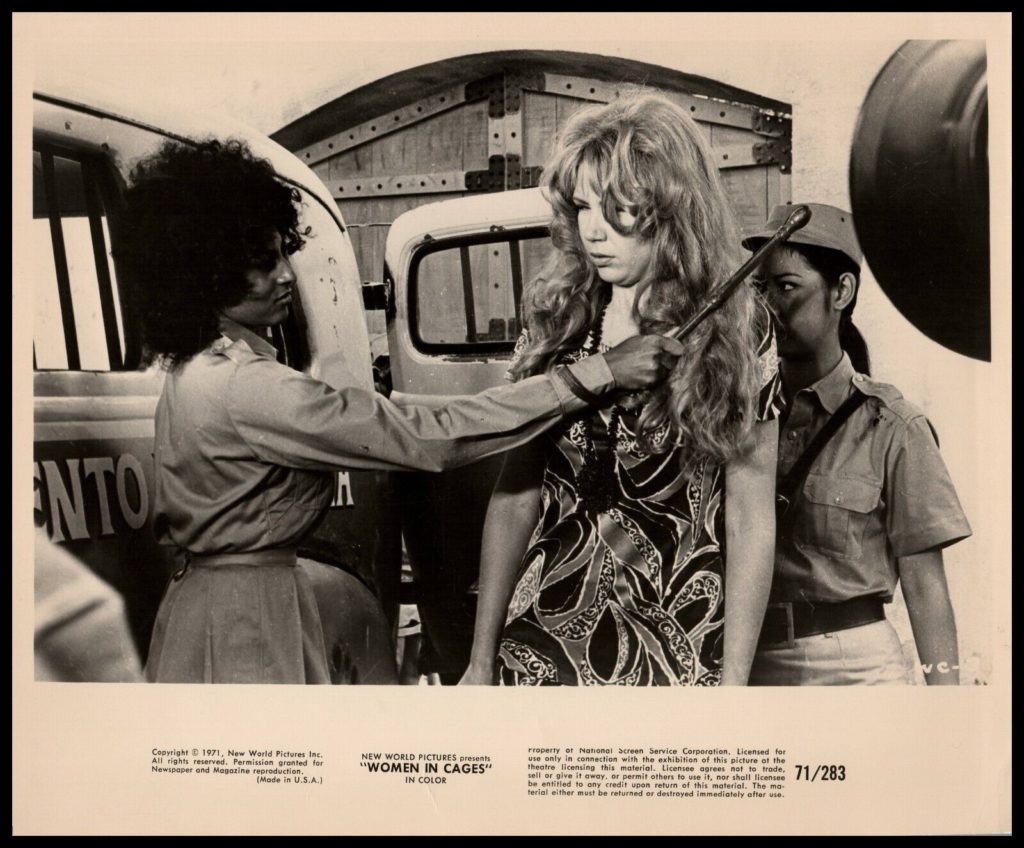
In many ways, WOMEN IN CAGES is the inverse of THE BIG DOLL HOUSE. Similar in structure, yet opposite in tone, as director Gerardo de Leon and writers David R. Osterhout and James H. Watkins leave out the comedy and camp moments from THE BIG DOLL HOUSE for a much more dire women-in-prison film, with Grier taking the reigns as the evil prison matron Alabama, and Jennifer Gan (1969’s NAKED ANGELS) taking over as the sweet and completely naive protagonist from DOLL HOUSE’s Judith Brown, who also appears in WOMEN IN CAGES as cellmate Sandy. “[WOMEN IN CAGES] was great but we didn’t have Jack so it wasn’t as much fun,” recalled Brown to Wadell.
Grier recalled a similar experience. “During the course of shooting WOMEN IN CAGES, we stayed in areas so remote you could get eaten alive by bugs and lost forever with no hope of rescue.”
Undeterred, Corman stuck with the Philippines. “One of the reasons I kept going back to the Philippines was that it was a very interesting tropical location,” Corman told Armstrong in Vol. 1 of his New World Pictures Oral History. “Also, the cost was very low. I could get a bigger-looking picture for very little money in Manila.”
For his next women-in-prison film, Corman looked to his ANGELS HARD AS THEY COME (1971) team of director Joe Viola and producer Jonathan Demme for 1972’s THE HOT BOX. The two men wrote the script based on Viola’s treatment. “He [wrote] it in an afternoon,” Corman wrote in his autobiography How I Made a Hundred Movies in Hollywood and Never Lost a Dime.
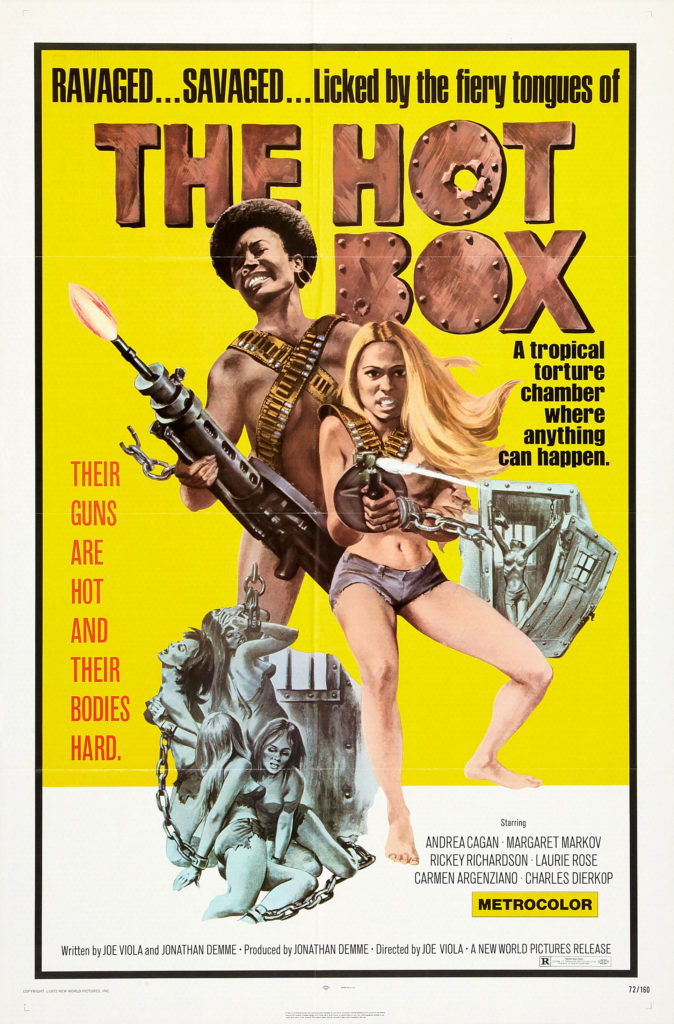
Once in production, Demme got his first taste of being behind the camera. “[W]e made THE HOT BOX in the Philippines and encountered monsoons,” Demme explained to the DGA Quarterly. “We went way behind schedule and it became necessary to have a second unit, so I became the second unit director to shoot these battle scenes. What the hell? I went out to shoot and fell instantly in love with directing.”
Another women-in-prison film was soon to follow, as Jack Hill teamed once again with Pam Grier and Sid Haig for 1972’s THE BIG BIRD CAGE. “What I wanted to do was to get away from the genre because there had been one limitation after another,” Hill told Waddell. “So I tried to do it differently.”
So successful was THE BIG DOLL HOUSE that Hill was given writing honors for his follow-up. “When you’ve got a hit picture, you want to come out with a sequel right away,” Hill told Armstrong in Roger Corman’s New World Pictures An Oral History, Vol. 1. The results were a much more comedic attempt at a women in prison film. “I did it the way that I thought would be best and tried to get a lot of humor into it.”
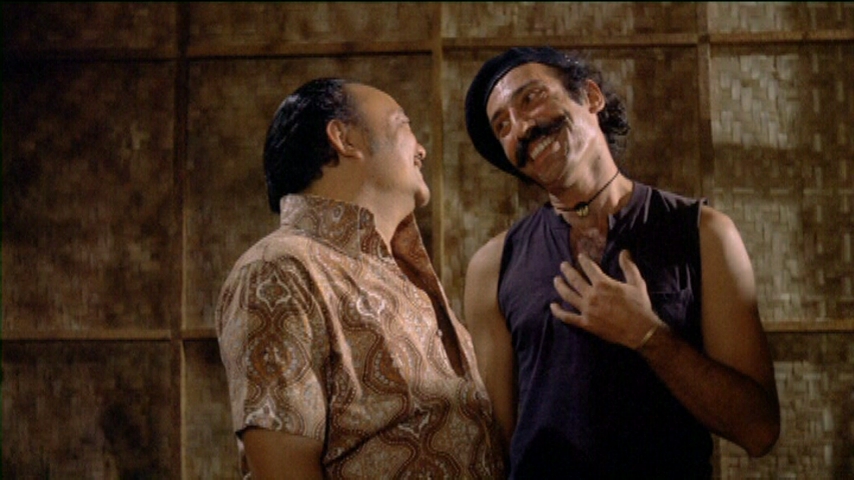
By 1972, the women-in-prison sub-genre was in full swing, with many wanting to capitalize on the profits Corman had made with THE BIG DOLL HOUSE. Italian director/producer Sergio Garrone was already enjoying a career writing and directing Westerns in Italy, such as 1969’s NO ROOM TO DIE (aka NOOSE FOR DJANGO) and DJANGO THE BASTARD, but he took a break to write and produce THE CRUCIFIED GIRLS OF SAN RAMON which was released in Italy in the May of 1972. The film did not go unnoticed by Larry Woolner, who was hoping to grab the U.S. distribution rights. However, Woolner didn’t want them for New World Pictures.
After a year at New World, it seemed the very man who suggested making a movie with “these” to Corman, had decide to literally move across the street to start his own company, Dimension Pictures (located at 9000 Santa Monica Boulevard to Corman’s New World building at 8831). “Larry had never seen money like this,” Corman explained in his autobiography. “But after a year he felt he wanted his own company. When I bought him out we went for a drink and Larry said it was the greatest year of his life.”
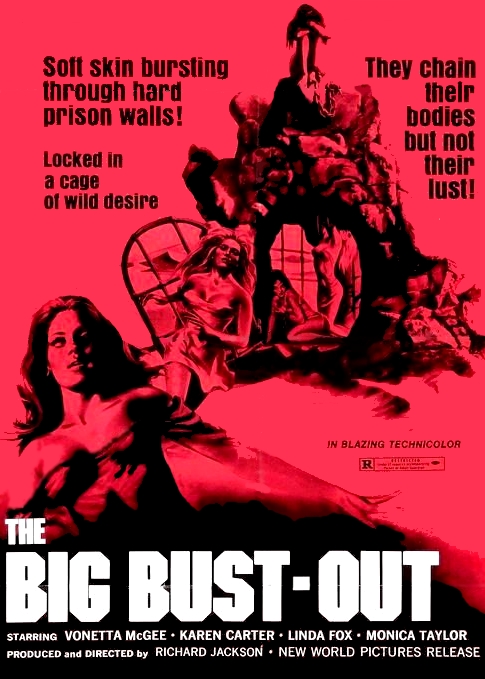
Woolner did not leave alone. During his exodus, he also brought with him director Stephanie Rothman (THE STUDENT NURSES, THE VELVET VAMPIRE) and her producer husband Charles S. Swartz (who was also New World’s head of production) who were brought in not only as partners in the company, but as creators for Dimension’s output, with the husband and wife team eventually creating three films for the company.
In the buyout, Woolner inherited the property of SWEET SUGAR, a BIG DOLL HOUSE riff that would soon become Dimension’s first production. Woolner hoped that THE CRUCIFIED GIRLS OF SAN RAMON would add to Dimension’s slate, but Corman had other ideas. While Woolner was flying to Rome to buy the film, Corman got on the phone and purchased it before Woolner’s plane even landed. While Corman has called their split “amicable,” when it comes to film distribution, perhaps friendship doesn’t enter into it.
THE CRUCIFIED GIRLS OF SAN RAMON, newly re-titled THE BIG BUST-OUT, was the only women-in-prison film New World Pictures would release in 1973 (though, as the new title suggests, they aren’t in prison for long), and in a much shorter form than when it debuted in Italy the year before, with Corman cutting the film from 95 to 75 minutes. In typical Corman fashion, the nudity was left intact.
While Woolner missed out on THE BIG BUST-OUT, he would soon rebound with 1973’s TERMINAL ISLAND (our Nearly New World selection this month) . Directed and co-written by Rothman, the film would be Dimension’s last attempt at a women-in-prison film, this time pitting both male and female prisoners (including SWEET SUGAR’s Phyllis Davis and future Magnum P.I. co-stars Roger E. Moseley and Tom Selleck) together on a remote island, eschewing the typical prison location altogether.
Following THE HOT BOX, Demme and Viola were far from done with women-in-prison films, penning a script called CHAINS OF HATE which Corman passed on to Ashley and Romero (who made the film as BLACK MAMA, WHITE MAMA and sold it to AIP), while Demme was itching to get back behind the camera.
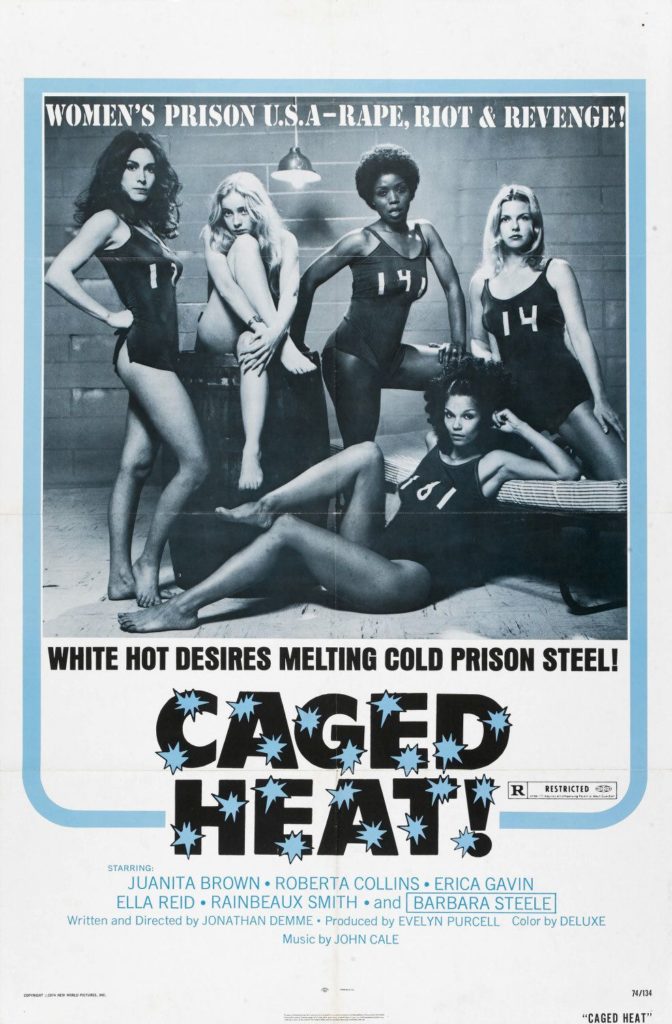
“When we came back from the Philippines, I asked Roger if there was any chance of directing, and he said, ‘Okay, write a women’s prison movie,’” Demme told EW. “At New World in those days, the titles and play dates were set before there was even a script. Roger made sure that he could book a women’s prison movie in thousands of theaters, and then he’d say, ‘Okay, we better make this.’”
Demme worked on the script for a year, with input from Doel, but Corman wasn’t sold. “I decided not to finance the project because the cycle had peaked,” Corman explained. “But I liked Jonathan’s work. He got his own financing and I agreed to distribute the film.”
“I had a 20-day schedule, not knowing what the hell I was doing,” Demme admitted. The results, however, won over Corman, who liked the film and immediately put Demme to work on directing 1975’s CRAZY MAMA and 1976’s FIGHTING MAD (for Corman’s deal with 20th Century Fox), Demme’s last two projects for Corman.
Following CAGED HEAT, Roger Corman – and therefore New World Pictures – was out of the women-in-prison sub-genre, as the boom fizzled out until the early 1980’s when the sub-genre busted back out with titles like THE CONCRETE JUNGLE (1982) and CHAINED HEAT (1983). New World Pictures, now sold by Roger Corman to Larry Kupin, Harry Sloan, and Larry A. Thompson would soon jump back into sub-genre with the director of THE CONCRETE JUNGLE at the helm.
Having started out in adult films, director Tom DeSimone had crossed over into mainstream films with 1977’s CHATTERBOX which inexplicably was NOT released by New World Pictures, despite the seemingly Corman-friendly premise of a woman with a talking vagina. Following 1981’s HELL NIGHT and THE CONCRETE JUNGLE, DeSimone had no project lined up and decided to write his own version of the women-in-prison film, a project that would eventually end up at New World.
“REFORM SCHOOL GIRLS was a production that was completely driven by home video,” director and then-New World Executive Tony Randel told us in an interview. “Roy Cox was the head of Video at that time and he wanted this movie. I was assigned to it and we did this film under the radar [with] very little interference [from the studio] and it did extremely well.”
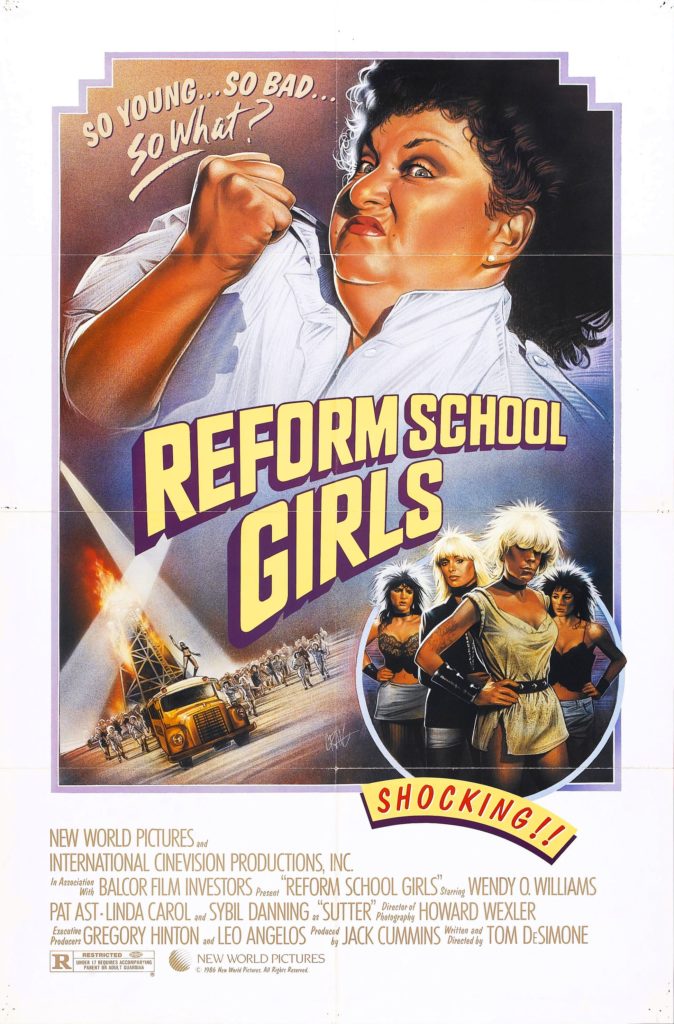
Not that everyone at New World was thrilled with the idea of REFORM SCHOOL GIRLS, a film that producer Jack Cummins described in the production notes by saying: “what we’re attempting to do here is to exploit exploitation.”
“It was this bastard child. The hoity-toity part of production wanted nothing to do with it, but I was willing to get in the muck and do an exploitation film because I had come from that background,” Randel recalled with a laugh. “And it did really well. It did better than the other things they were doing there at the time, actually, which was a bit of an embarrassment [for them], I think.”
For more on REFORM SCHOOL GIRLS, look out for our episode on it coming next week, and our interview with writer/director Tom DeSimone the week after!
* In his autobiography, Corman claims THE BIG DOLL HOUSE cost $125,000 and made $3 million. It did make $4 million when it was released overseas by MGM, but the main takeaway is, regardless of the actual figures, the film was a success.
